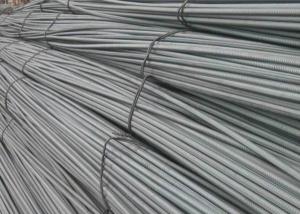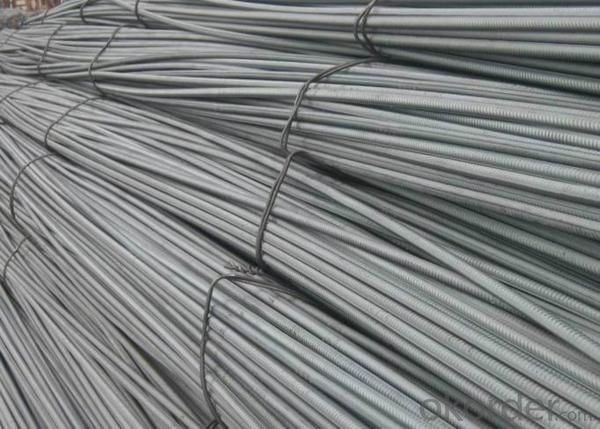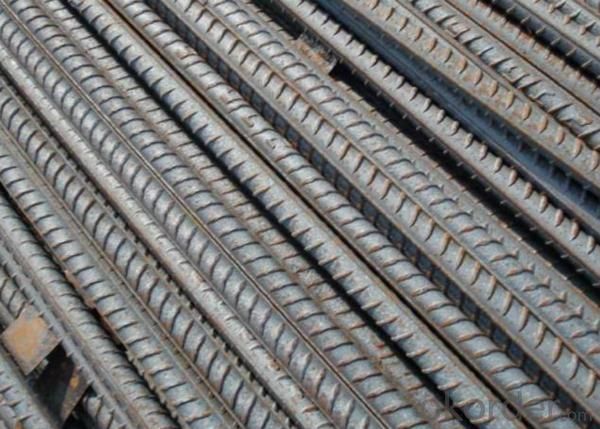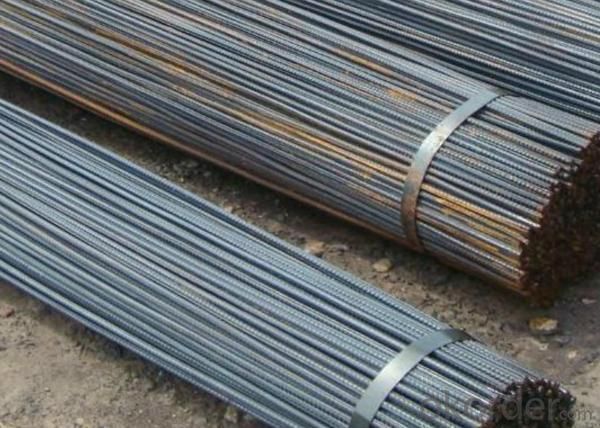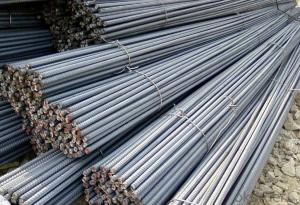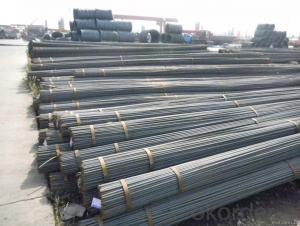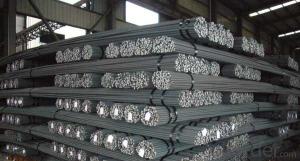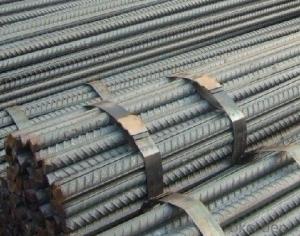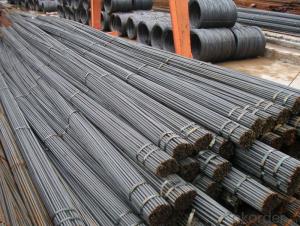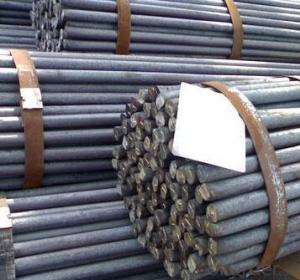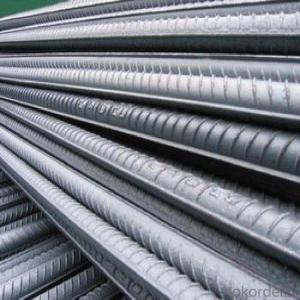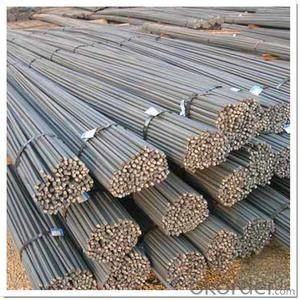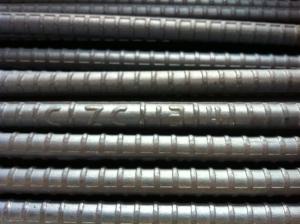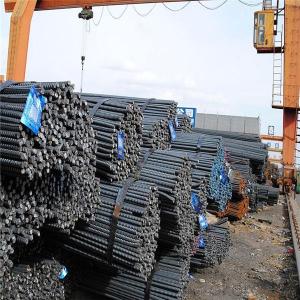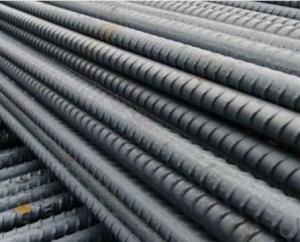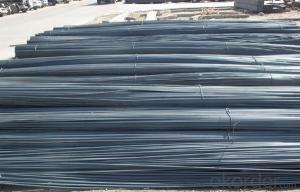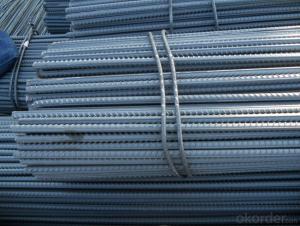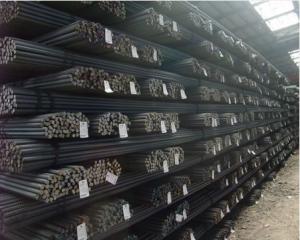HRB335 Steel Rebars
- Loading Port:
- China Main Port
- Payment Terms:
- TT or LC
- Min Order Qty:
- 50MT m.t.
- Supply Capability:
- 800000TONS m.t./month
OKorder Service Pledge
OKorder Financial Service
You Might Also Like
Specifications of HRB335 Steel Rebars:
Standard | GB | HRB335 | |
Diameter | 6mm,8mm,10mm,12mm,14mm,16mm,18mm,20mm, 22mm,25mm,28mm,32mm,36mm,40mm,50mm | ||
Length | 6M, 9M,12M or as required | ||
Place of origin | Hebei, China mainland | ||
Application | building,construction,road,bridge etc | ||
Technique | Hot rolled | ||
Brand name | DRAGON | ||
Chemical Composition: (Please kindly find our chemistry of our material based on HRB335 as below for your information)
Grade | Technical data of the original chemical composition (%) | |||||
C | Mn | Si | S | P | B | |
HRB335 | ≤0.25 | ≤1.60 | ≤0.80 | ≤0.045 | ≤0.045 | >0.0008 |
Physical capability | ||||||
Yield Strength (N/cm²) | Tensile Strength (N/cm²) | Elongation (%) | ||||
≥335 | ≥490 | ≥16 | ||||
Theoretical weight and section area of each diameter as below for your information:
Diameter(mm) | Section area (mm²) | Mass(kg/m) | Weight of 12m bar(kg) |
6 | 28.27 | 0.222 | 2.664 |
8 | 50.27 | 0.395 | 4.74 |
10 | 78.54 | 0.617 | 7.404 |
12 | 113.1 | 0.888 | 10.656 |
14 | 153.9 | 1.21 | 14.52 |
16 | 201.1 | 1.58 | 18.96 |
18 | 254.5 | 2.00 | 24 |
20 | 314.2 | 2.47 | 29.64 |
22 | 380.1 | 2.98 | 35.76 |
25 | 490.9 | 3.85 | 46.2 |
28 | 615.8 | 4.83 | 57.96 |
32 | 804.2 | 6.31 | 75.72 |
36 | 1018 | 7.99 | 98.88 |
40 | 1257 | 9.87 | 118.44 |
50 | 1964 | 15.42 | 185.04 |
Usage and Applications of HRB335 Steel Rebars:
Deformed bar is widely used in buildings, bridges, roads and other engineering construction. Big to highways, railways, bridges, culverts, tunnels, public facilities such as flood control, dam, small to housing construction, beam, column, wall and the foundation of the plate, deformed bar is an integral structure material. With the development of world economy and the vigorous development of infrastructure construction, real estate, the demand for deformed bar will be larger and larger..
Packaging & Delivery of HRB335 Steel Rebars:
Packaging Detail: products are packed in bundle and then shipped by container or bulk vessel, deformed bar is usually naked strapping delivery, when storing, please pay attention to moisture proof. The performance of rust will produce adverse effect.
Each bundle weight: 2-3MT, or as required
Payment term: TT or L/C
Delivery Detail: within 45 days after received advanced payment or LC.
Label: to be specified by customer, generally, each bundle has 1-2 labels
Trade terms: FOB, CFR, CIF
Steel Rebars in coil
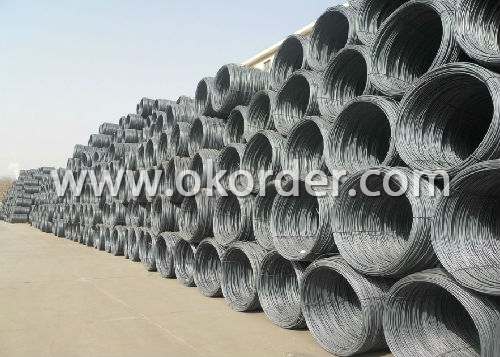
production line of Steel Rebars

Note:
1. Our products are produced according to national standard (GB), if not, supply according to national standards (GB) or agreement as customer required.
2. Other Grade and Standard Deformed Steel Bar we can supply:
Grade: GR40/GR60, G460B/B500A/B500B/B500C,BST500S
Standard: ASTM, BS, DIN
The Minimum Order Quantity of these products is high, and need to be confirmed.
3. We can not only supply Deformed Steel Bar; if you need anything about building materials, please contact us for further information.
4. Please send us your detail specifications when inquire. We will reply to you as soon as possible. We sincerely hope we can establish a long stable business relationship.
- Q: What are the guidelines for proper storage and transportation of steel rebars?
- The guidelines for proper storage and transportation of steel rebars are essential to ensure their integrity and quality. Here are some important guidelines to follow: 1. Storage: Steel rebars should be stored in a clean, dry, and well-ventilated area to prevent corrosion. They should be placed on a flat surface to avoid distortion or bending. Stacking should be limited to prevent excessive weight on the lower rebars, which can lead to deformation. 2. Protection: Steel rebars should be protected from exposure to moisture, rain, and direct sunlight. They should be covered with a waterproof tarp or plastic sheeting to prevent rusting. Rust can weaken the rebars and compromise their structural integrity. 3. Separation: Different sizes and grades of rebars should be stored separately to avoid confusion and ensure easy access. Additionally, rebars should be kept away from other materials that can cause damage or contamination. 4. Handling: When handling steel rebars, proper lifting techniques should be employed. Forklifts or cranes with appropriate lifting equipment should be used to prevent damage or injuries. The rebars should not be dragged or dropped, as this can cause deformation or cracking. 5. Transportation: During transportation, steel rebars should be secured properly to prevent shifting or movement that can lead to damage. Adequate cushioning materials, such as wooden blocks or rubber pads, should be used to minimize vibration and impact. Additionally, rebars should be covered to protect them from road debris and adverse weather conditions. 6. Documentation: Proper documentation is necessary for tracking the origin, size, and grade of the rebars. This information helps in ensuring compliance with industry standards and quality control measures. By adhering to these guidelines, the risk of damage, deformation, and corrosion to steel rebars during storage and transportation can be significantly reduced. This ensures that the rebars maintain their structural integrity and are fit for use in construction projects.
- Q: What are the different methods for attaching steel rebars to existing structures?
- Attaching steel rebars to existing structures can be done using various methods, depending on the project's specific requirements and conditions. Some commonly used methods include: 1. Utilizing welding techniques: By employing welding techniques, rebars can be securely attached to the existing structure. This method offers a robust and long-lasting connection, but it necessitates skilled labor and may not be applicable in all situations. 2. Employing epoxy bonding: Epoxy adhesives can be utilized to bond rebars to existing structures. This method is simple to apply and provides a reliable connection, particularly when the rebars are embedded in concrete. However, it is crucial to ensure proper surface preparation and adhere to the manufacturer's instructions for optimal results. 3. Utilizing mechanical anchoring: Rebars can be attached to existing structures using mechanical anchors like anchor bolts or expansion anchors. This method involves drilling holes into the structure and inserting the anchor, which ensures a secure connection. Selecting the appropriate anchor type and size based on the load requirements and structural conditions is essential. 4. Employing clamping or fastening: In some instances, clamps or fasteners can be used to attach rebars to existing structures. This method is relatively quick and easy to install, but it may not provide as strong of a connection as welding or epoxy bonding. 5. Overlapping rebars: When reinforcing existing concrete structures, rebars can be overlapped with the existing reinforcement and tied together using wire or other methods. This method is commonly employed in construction to maintain reinforcement continuity and enhance load-carrying capacity. It is crucial to consult with structural engineers or professionals experienced in rebar installation to determine the most suitable method for attaching steel rebars to existing structures. They will consider factors such as structural integrity, load requirements, and local building codes to ensure a safe and effective connection.
- Q: What are the fire resistance properties of steel rebars?
- Steel rebars have excellent fire resistance properties due to their high melting point and low thermal conductivity. They do not burn or contribute to the spread of fire. In case of a fire, steel rebars maintain their structural integrity and can help in preventing the collapse of a building or structure.
- Q: JL32 is the finish thread heavy bar 32? What's the difference between normal and ordinary? What does the front JL32 mean?
- Finishing rolling rebar strength than ordinary ribbed steel bars to be high, with spiral thread, tension nut after solid increase concrete prestressed (equivalent prestressed steel wire, steel wire type).
- Q: Do steel rebars affect the weight of a structure?
- Yes, steel rebars do affect the weight of a structure. Rebars, also known as reinforcing bars, are steel bars used to reinforce concrete structures. When concrete is poured, rebars are embedded within it to provide additional strength and support. Since steel is much denser than concrete, the addition of rebars increases the overall weight of the structure. However, the weight increase is relatively small compared to the benefits gained in terms of structural integrity and load-bearing capacity. Rebars help distribute the load more evenly throughout the structure, making it more resistant to bending, cracking, and collapsing under heavy loads. Therefore, while rebars do add some weight to a structure, the advantages they bring in terms of safety and longevity far outweigh the slight increase in weight.
- Q: Can steel rebars be used in structures with limited construction timeframes?
- Structures with limited construction timeframes can indeed utilize steel rebars. These rebars are frequently employed in construction projects due to their remarkable tensile strength, making them ideal for reinforcing concrete structures. Speedy and efficient installation is achievable with steel rebars, enabling faster construction compared to alternative reinforcement materials. Moreover, steel rebars offer durability and long-term stability, guaranteeing the integrity of the structure, even in time-constrained projects. Hence, employing steel rebars proves to be an effective solution for structures with limited construction timeframes, as they deliver both strength and swiftness in the construction process.
- Q: What is the process of anchoring steel rebars in masonry walls?
- The process of anchoring steel rebars in masonry walls involves several steps. Firstly, the masonry wall is constructed, leaving gaps or voids where the rebars will be inserted. Secondly, the rebars are cut to the desired length and then inserted into the pre-determined positions in the wall. Next, the rebars are securely anchored or tied to the masonry using various methods such as tying them with wire or using specialized anchoring devices. This ensures that the rebars are firmly embedded within the masonry structure, providing reinforcement and strength to the wall. Finally, the rebars are inspected to ensure they are properly anchored and meet the required specifications and standards.
- Q: Can steel rebars be used in coastal construction?
- Yes, steel rebars can be used in coastal construction. Steel rebars are commonly used in construction projects, including in coastal areas where they provide crucial reinforcement to concrete structures. The steel rebars are typically coated or treated to prevent corrosion from the saltwater and other coastal elements, ensuring their durability and longevity in coastal environments.
- Q: How do steel rebars affect the overall constructability of concrete structures?
- Steel rebars have a significant impact on the overall constructability of concrete structures. Rebars, also known as reinforcing bars, are embedded within the concrete to provide strength and enhance its structural integrity. These steel bars play a crucial role in resisting tensile forces that concrete alone cannot withstand. One of the primary ways rebars affect constructability is by increasing the load-bearing capacity of concrete structures. By reinforcing the concrete, rebars help distribute the applied loads more evenly, reducing the risk of structural failure or collapse. This allows for the construction of taller, larger, and more complex concrete structures that can safely accommodate heavier loads. Moreover, rebars also improve the durability and longevity of concrete structures. Concrete is strong in compression but weak in tension, making it susceptible to cracking and failure under tensile stress. The presence of steel rebars helps to counter this weakness by absorbing and distributing the tensile forces, preventing or minimizing cracks and enhancing the overall durability of the structure. In terms of constructability, the use of rebars simplifies the construction process by allowing for efficient and precise placement of concrete. Rebar cages are typically assembled prior to pouring the concrete, acting as frameworks that provide support and reinforcement. This enables faster and more accurate construction, reducing the risk of errors and rework. Furthermore, rebars also enhance the constructability of concrete structures by enabling flexibility in design. The ability to strategically position and shape rebars allows engineers to create complex structural elements, such as beams, columns, and slabs, with specific load-bearing capabilities. This versatility in design promotes architectural creativity while ensuring the structural integrity of the construction. However, it is important to note that the improper placement or inadequate amount of rebars can have detrimental effects on the constructability and overall performance of concrete structures. Insufficient reinforcement can lead to structural weaknesses, increased vulnerability to seismic activity, and reduced resistance to environmental factors like corrosion. Therefore, proper design and installation of rebars, in accordance with structural engineering standards and codes, are crucial to ensure the optimal constructability and long-term functionality of concrete structures.
- Q: Can steel rebars be used in historical monument conservation?
- Yes, steel rebars can be used in historical monument conservation. They are commonly used to reinforce and strengthen structures, including historical monuments, to ensure their stability and longevity. However, it is important to carefully consider the specific requirements and limitations of each monument to ensure that the use of steel rebars does not compromise its historical integrity or aesthetic value.
1. Manufacturer Overview
| Location | Hebei, China |
| Year Established | 2002 |
| Annual Output Value | Above US$ 400 Million |
| Main Markets | South Asia; Middle East;Southeast Aisa |
| Company Certifications |
2. Manufacturer Certificates
| a) Certification Name | |
| Range | |
| Reference | |
| Validity Period |
3. Manufacturer Capability
| a) Trade Capacity | |
| Nearest Port | Tianjin |
| Export Percentage | 60%-80% |
| No.of Employees in Trade Department | 11-20 People |
| Language Spoken: | English; Chinese |
| b) Factory Information | |
| Factory Size: | Above 100,000 square meters |
| No. of Production Lines | 2 |
| Contract Manufacturing | OEM service offered |
| Product Price Range | average |
Send your message to us
HRB335 Steel Rebars
- Loading Port:
- China Main Port
- Payment Terms:
- TT or LC
- Min Order Qty:
- 50MT m.t.
- Supply Capability:
- 800000TONS m.t./month
OKorder Service Pledge
OKorder Financial Service
Similar products
Hot products
Hot Searches
Related keywords
